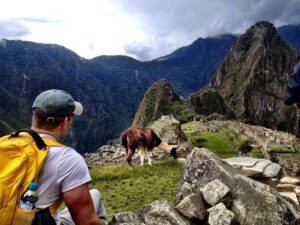The Inca Trail to Machu Picchu is more than just a hike—it’s a soul-stirring journey through history, nature, and personal challenge. As one of the most iconic trekking routes in the world, this legendary path invites you to walk in the footsteps of the ancient Incas, surrounded by breathtaking Andean peaks, lush cloud forests, and sacred archaeological sites.
This guide is your complete companion to preparing for the Inca Trail trek, whether you’re an experienced adventurer or planning your first multi-day hike in Peru.
1. What Is the Inca Trail?
The Inca Trail is a vast network of ancient paths once used by the Inca Empire, stretching over 70,000 kilometers across South America. The most renowned segment is the Classic Inca Trail to Machu Picchu, a 4-day, 45-kilometer (28-mile) hike that begins at Kilometer 82 near Ollantaytambo, know as route 1. This route weaves through dramatic landscapes, cloud forests, and hidden ruins until it culminates at Inti Punku, the Sun Gate—offering the first breathtaking view of Machu Picchu.
Along the way, trekkers explore magnificent archaeological sites such as Llactapata, Runkurakay, Sayacmarca, Phuyupatamarca, Wiñay Wayna and Sun Gate.
Additionally, the Machu Picchu Historical Sanctuary includes other original Inca trail routes:
Route 1: Piskacucho (Km 82)
Route 2: Qoriwayrachina
Route 3: Salkantay via Paucarcancha
Route 4: Piso Valley (No Available)
Route 5: Chachabamba (Km 104 – Short Inca Trail)
2. Why Trek the Inca Trail?
Unlike taking the train, trekking the Inca Trail immerses you in Peru’s natural beauty and cultural richness. It’s one of the top 10 treks in the world for a reason:
- Experience stunning landscapes only accessible by foot
- Camp under a sky filled with stars
- Visit ancient ruins rarely seen by day-trippers
- Enter Machu Picchu through its original ceremonial entrance
It’s not just a trek—it’s a transformative journey.
3. Permits & Regulations
Because of its popularity and to preserve its integrity, the Inca Trail is strictly regulated:
- Daily permits are limited to 500 people, including guides and porters
- Permits sell out months in advance, especially from May to September
- Booking must be made through an authorized tour operator
- Solo trekking is not allowed
4. Best Time to Hike the Inca Trail
- Dry Season (April to October): Clear skies and great views, but also peak season
- Shoulder Months (March & November): Fewer crowds, but more rain
- February: Trail closed for maintenance
5. Physical Preparation
The Inca Trail trek is moderately challenging, especially due to altitude. Here’s how to prepare:
- Engage in cardio workouts and strength training
- Practice day hikes with your gear and pack
- Spend 2-3 days in Cusco (3,400m) to acclimate
6. What to Pack
Here’s a quick Inca Trail packing list:
Essentials:
- Broken-in hiking boots
- Trekking poles
- Layered, moisture-wicking clothing
- Rain gear (jacket or poncho)
- Hat, sunglasses, sunscreen
- Refillable water bottle or hydration bladder
- Small daypack
- Sleeping bag (check if your tour provides it)
- Headlamp
- Personal medication
Optional:
- Camera or smartphone
- Power bank
- Snacks (energy bars, nuts)
- Lightweight sandals for camp
Your tour company will usually provide a duffel bag, carried by porters, with a weight limit (usually 6-7kg per person).
7. What to Expect Each Day
Day 1: Easy Start
Mostly flat terrain through the Sacred Valley and Inca ruins like Llactapata.
Day 2: Challenge Day
Climb to Dead Woman’s Pass (4,215m) — the highest point of the trek. It’s the toughest day.
Day 3: Inca Ruins Galore
Pass through beautiful cloud forests and ruins like Phuyupatamarca and Wiñay Wayna.
Day 4: The Reward
Early start to reach the Sun Gate and see Machu Picchu at sunrise. After a guided tour, you can explore the site or hike Huayna Picchu (if booked in advance).
8. Choosing a Tour Operator
To ensure a safe and ethical experience, choose a certified Inca Trail tour provider that:
- Treat porters fairly.
- Provide quality gear (tents, sleeping pads).
- Offer good food and medical support.
- Have positive reviews and clear communication.
9. Tips for a Great Experience
- Acclimatize in Cusco for a couple of days before the trek
- Drink plenty of water
- Bring coca leaves or altitude sickness medication
- Travel light but smart
- Respect local communities, traditions, and nature
10. Final Thoughts
The Inca Trail to Machu Picchu is a once-in-a-lifetime adventure. It combines physical challenge, cultural immersion, and emotional fulfillment. As you follow the ancient paths through the Andes and finally gaze upon Machu Picchu from the Sun Gate, you’ll understand why this trek is considered one of the most magical experiences in the world.
Whether you’re chasing a dream, seeking connection, or simply answering the call of adventure, the Inca Trail trek will leave you transformed.
Ready to take the first step? The trail awaits.



